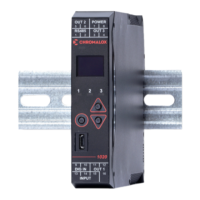74
PID Control
Proportional Integral and Derivative control maintains
accurate and stable levels in a process (e.g. tempera-
ture control). It avoids the oscillation characteristic of
On-Off control by continuously adjusting the output to
keep the process variable stable at the desired Set-
point.
Also refer to Automatic Reset, Controller, Manual
Mode, On-Off Control, PI Control, Heat Proportional
Band, Process Variable, Rate, Cool Proportional Band,
Setpoint and Tuning
Pre-Tune
Starting with the load cool*, Pre-Tune disturbs the pro-
cess start-up pattern, so that the PID values are calcu-
lated before the setpoint is reached.
During Pre-Tune, the controller outputs full Heat Power
until the process value has moved approximately half-
way to the Setpoint. At that point, power is removed
(or full Cool Power with dual control), thereby introduc-
ing a process oscillation. Once the oscillation peak has
passed, the instrument calculates the PID tuning terms:
proportional band(s), automatic reset and rate. Normal
PID control operation begins using these calculated
values, and Pre-Tune automatically disengages.
*Ideally the Tune program should be used when the
load temperature is close to ambient.
Care should be taken to ensure that any overshoot is
safe for the process and if necessary tune at a lower
setpoint.
Pre-Tune will not engage if either Heat or Cool outputs
on a controller are set for On-Off control, the control-
ler is set to Manual, during Setpoint ramping, or if the
process variable is less than 5% of the input span from
the Setpoint. Refer to the Automatic Tuning section for
further details.
Also refer to Automatic Reset, On-Off Control, Input
Span, PID, Heat Proportional Band, Process Vari-
able, Rate, Cool Proportional Band, Setpoint, Setpoint
Ramping and Tuning.
PV High Alarm Value
Refer to Alarm Operation.
PV Low Alarm Value
Refer to Alarm Operation.

